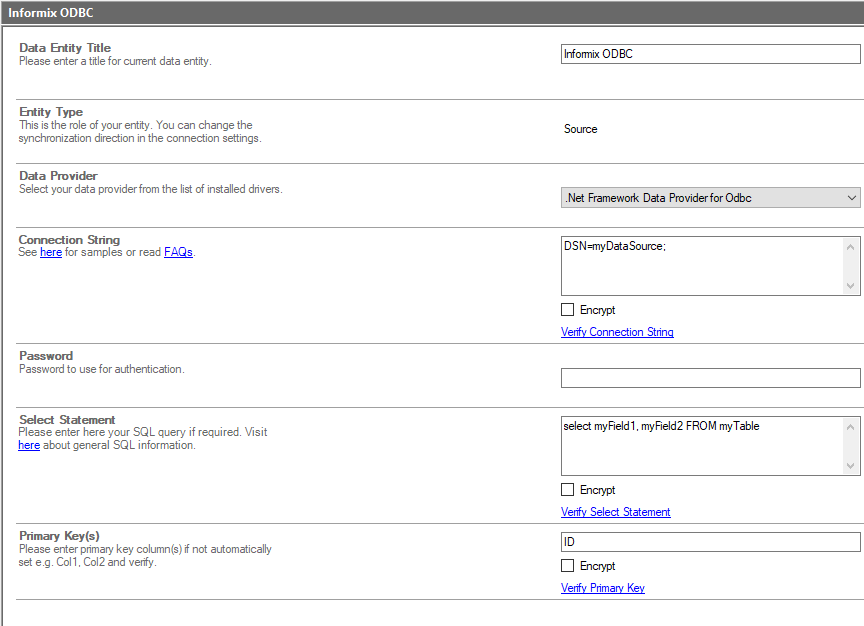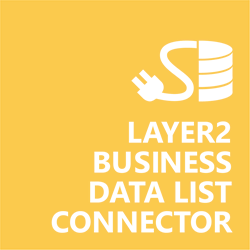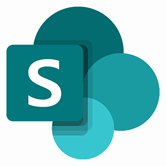Keep your IBM Informix in sync. Download and try today.
IBM Informix Data Integration with SharePoint
IBM Informix data sources can be integrated codeless with native SharePoint lists using the Layer2 Business Data List Connector. You can also connect to 100+ more supported systems and applications. In case you are looking for Online data integration, you will find the right tool here.

Benefits of IBM Informix Integration in SharePoint
- Very easy to setup in a few minutes: Create a SharePoint list, click "Connect to external data source" in the list settings, select the data provider, enter connection settings and data query as shown below. That's it.
- No changes in the ODBC data source required: No programming, no additional tools.
- Connected list data always up-to-date: The connected ODBC data query updates automatically in background (via SharePoint Timer Job), or alternatively, on-demand (Action Menu / Ribbon Button, URL, via workflow, API).
- One-way and optional two-way connection: You can write-back the changes made in the SharePoint list to the external ODBC data source automatically with full CRUD (Create / Update / Delete) functionality. The SharePoint list can act as a full-featured front-end for external systems.
- Well-known BCS "external list" issues and limitations are completely solved: ALL list features are to you. Views, sorting and grouping, filters, calculated fields, search, managed metadata. Lookups, additional columns and attachments can be created as normal. All kind of lists can be used, e.g. contacts, tasks, calendar, or custom lists. You can take external data offline via Outlook.
- Workflows and notifications on external data change: List workflows and change notifications per RSS or email can be used to take business actions in SharePoint, when external ODBC data records are changed.
- Application logging, reporting, and notifications: A SharePoint list is used to store settings and log information. SharePoint item versioning and workflows can be used to manage reporting and notifications. Direct notification per email in case of errors is supported as well.
- Highest Security, best performance, easy to maintain: SharePoint Secure Store can be used to store security relevant configuration information safely in one central place. Users are working with the SharePoint lists as an external data cache with highest security and performance. Large data sources can be synchronized.
- 100+ more external systems supported: Layer2 Data Providers included (e.g. for external SharePoint or Office 365, Exchange, Dynamics ERP/CRM, OData, XML/RSS, SOAP), vendor specific data providers can be used (e.g. SQL Server Oracle, MySQL etc.), 3rd party data providers also supported, e.g. for custom ERP/CRM, Facebook or Twitter. See here for supported systems and applications.
IBM Informix Specific SharePoint List Configuration Settings
In the SharePoint General List Settings click "Connect to external data source". In the BDLC form, the data source must be configured as follows to connect to IBM Informix using the ODBC driver.

Figure 1: Example connection configuration to connect a native SharePoint list to an IBM Informix ODBC data source via Layer2 Business Data List Connector.
Please note the following specific settings.
- Download and install the appropriate Informix Client SDK package, which will install the ODBC drivers. Note that the driver must be the 64-bit version to work with BDLC.
- Use a System DSN (not User or File DSN) to setup your connection and to refer to in the connection string. If the SetNet32 settings were configured, the Informix driver should automatically detect the databases you can use and fill in the details. Otherwise, you will need to configure that per the Informix ODBC DSN Configuration instructions.

Figure 2: An example Informix ODBC configuration in the ODBC Data Source Administrator.
- Select the ODBC Data Provider to connect. The provider is part of the Windows Operating System and should be already installed.
- You can use a connection string like this to connect:
DSN=myDSN; UID=myUser; PWD=myPassword - You can make use of ODBC to query your data as supported by the data provider and source system. For any specification of query language supported, see the IBM Informix Driver documentation.
- You can map your data fields to specific external source fields in the Layer2 Business Data List Connector. Please take care about data types (simple type conversions are supported).
- Please enter an appropriate primary key (column with unique values), depending on query (see data preview for this).
- You can use the connection for uni- or bi-directional (write-back) synchronization. In case of inserts (full CRUD) via external systems, please take care that the primary key is defined and appropriate.
- No installation or changes are required at the ODBC data source or data destination.
- No programming required for setup a connection and sync.
- No need to open your local network for access from outside.
ODBC Connection Details
Provider: .Net Framework Data Provider for ODBC
Connection string sample:
DSN=myDataSource;
Select Statement sample:
SELECT myField1, myField2 FROM myTable
For additional information, see the IBM Informix Driver documentation.
SharePoint Integration via IBM Informix ODBC - Examples, Known Issues and Workarounds
The integration of ODBC-related data sources in SharePoint has the following known issues and workarounds:
- In case of inserts (full CRUD) via external systems please take care that there is a defined primary key and that it is appropriate.
- Please make use of the bdlcGUID column that will have a unique GUID assigned automatically, if required.
- If you can't find any 64-bit driver, please use the Layer2 Cloud Connector(32-bit version) to connect.
- There are also ADO .NET drivers available and installed with the SDK, but they appear to require additional environment setup to work properly (see the IBM Informix .NET Provider documentation). The ODBC driver is known to work with BDLC, so if you have issues getting the .NET ones to work, you can switch to ODBC.
Ready
to go next steps?





